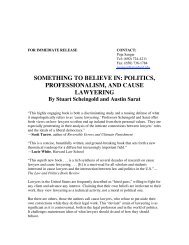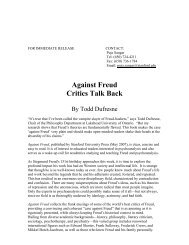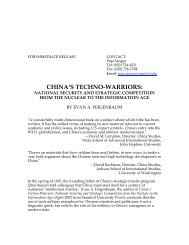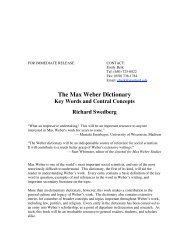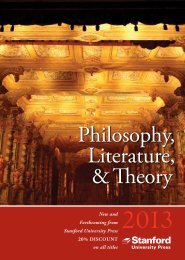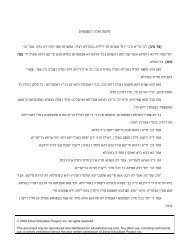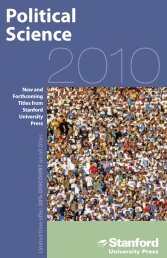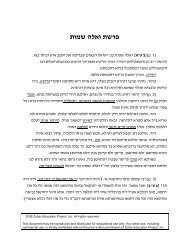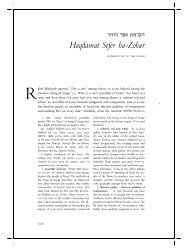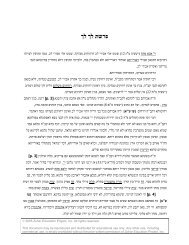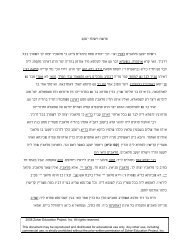Front Matter (PDF) - Stanford University Press
Front Matter (PDF) - Stanford University Press
Front Matter (PDF) - Stanford University Press
You also want an ePaper? Increase the reach of your titles
YUMPU automatically turns print PDFs into web optimized ePapers that Google loves.
in readingthe text is that of masteringthe symbolic language and the<br />
dif®culty<br />
with which it was employed.<br />
subtlety<br />
may also be that the Zohar's composition in Aramaic was not entirely a<br />
It<br />
of conscious choice. Perhaps it was somethingthat ``happened,'' either<br />
matter<br />
the author's psyche or in the community of mystics where Zoharic teachings<br />
in<br />
®rst shared orally. If there was a livingcommunity of kabbalists in<br />
were<br />
in the 1280s, meetingby night in courtyards and gardens to study the<br />
Castile<br />
of the Torah, in what language did they share those secrets with one<br />
secrets<br />
How did the transition take place from discussingthe Hebrew text of<br />
another?<br />
in CastilianÐtheir only spoken languageÐback into Hebrew or Ara-<br />
Torah<br />
for transcription onto the written page? Could it be that the richly<br />
maic,<br />
sound of AramaicÐwhere each noun ends in a vowelÐbetter re¯ected<br />
vocalic<br />
sounds of their own speech than did Hebrew? Were they themselves somehow<br />
the<br />
``seduced'' by the mysterious sound of Aramaic to follow it into the<br />
realm represented by the Zohar?<br />
fantasy<br />
speculations may also be applied to the written text itself, especially if<br />
These<br />
assume that Rabbi Moses de LeoÂn is the author of large portions of the<br />
we<br />
Some twenty Hebrew treatises by De LeoÂn have survived, and several of<br />
Zohar.<br />
have now been published. Compared to the Zohar, they are relatively dull<br />
these<br />
uninspired. While the doctrinal content is very much the same, they pos-<br />
and<br />
little of the poetic muse and freedom of expression that so characterize the<br />
sess<br />
One has the impression that De LeoÂn stepped into another world when<br />
Zohar.<br />
Zohar, and the transition from Hebrew to Aramaic was one of the<br />
writingthe<br />
he marked that portal. Workingin this other, more dimly perceived lan-<br />
ways<br />
released his muse, as it were, giving him the freedom to soar to heights<br />
guage<br />
imagination and literary excess that he would not have dared attempt in<br />
of<br />
We might almost say that the use of Aramaic was some part of ``the<br />
Hebrew.<br />
Name'' by which it was said that De LeoÂn hadwrittentheZohar.<br />
Holy<br />
Aramaic of the Zohar is indeed a unique composite of dialects and features<br />
The<br />
drawn from ancient literary sources. Details of Scholem's analysis of the<br />
language can be found in his writings and need not be repeated here.<br />
Zohar's<br />
also the Translator's Introduction to this volume for further discussion of<br />
See<br />
last two centuries of Jewish life in Spain, the Zohar continued to be<br />
Duringthe<br />
and studied amongsmall groups of devotees. It competed with two<br />
copied<br />
schools of kabbalistic thought, the Catalonian and the Abula®an, for the<br />
other<br />
of those few interested in mystical pursuits. Some kabbalists seem to<br />
attention<br />
combined these various approaches, or else to have ``migrated'' in the<br />
have<br />
of their own quests from one school of mystical thought to another.<br />
course<br />
Introduction<br />
lxxi<br />
linguistic questions that have direct bearing on the translation before you.<br />
X<br />
Jewish rationalism was also very much alive in Spain through the ®fteenth



